Service List Design. Have you ever called your phone/ insurance/ medical insurance company and had to give your details three times, or phone three different numbers to get your problem solved? Or wondered why, if you contract a service with a certain company, it’s a different company that comes to your house to install what you’ve contracted?
That’s where service design comes in, as an attempt to solve all these inconsistencies in services.
The need for this arises due to the transformation from an industrial society to a services society; designers must now solve ergonomic issues for both products and services, and that can at times be a highly complex task.
A services company has many points of contact with users. And putting all the pieces together so that they run smoothly means coordinating departments, resources and interfaces, and requires the will and the desire for a change of perspective from resources optimisation processes to client experience.
Industrial designers used to focus on solving ergonomics in relation to door handles, or making soap dispensers easy to use… But the industry has now changed, and the “door handles” of today are as complex to solve as the Paypal button.
What method is used in service unlimited graphic design?
Service design provides a work methodology which places people at the centre of all projects, and strives to define services from their perspective. The aim is to focus on the needs, aspirations, concerns and interests of the people using such services, in order to provide value-added experiences. Are the services available today in our society targeted at, and focused on, people’s needs?
But service design is not oblivious to the profitability and feasibility of the experience. It balances the needs and aspirations of the people making up the system (clients, workers and their environment) and the aims and limitations of the business.
Services stem from the industrial and product culture, and are provided by companies which were previously structured in silos; they have to work with separate departments, each with specific and differentiated tasks, thus making users perceive the company as fragmented, which in turn generates mistrust and a feeling that it does not meet their needs. We are now starting to see in our projects how efforts are being made to break such silos and focus company operations on users/clients.
Companies are starting to make a conscious effort – or have been doing so for a while – to understand who their existing and potential clients are, and what their environment is like. The aim is to offer a coherent experience to cover their needs.

The dimensions of Unlimited graphic design services
How does Service Design bring together all the needs of all these people and merge them with the service providers? It focuses on the people who will be using the service, as the central backbone of the whole project. The first stage of a service design project is to understand who the main actors are and create a vision of how they will use the service to be designed. Stories told from a single perspective, that of the user, and focusing on the ideal situation.
These stories have an impact on the various dimensions of the Service Design:
– Spaces
– People or agents
– Physical devices
– Communications
– Business
The service takes place in a space or spaces which, depending on the experiences we have thought up, will need to fulfil specific requirements. So, at this point the design method works with architects and interior designers to define the arrangement of all the elements within the space and flow of people therein.
More people are involved in the service than just the users we have defined as central to service design. And service design takes into account each and every one of the individuals who come into contact with the service at any time: service providers, people in the departments involved, external providers… This is, to a certain extent, the great challenge: working with people to understand not only their needs and concerns, but also their skills and knowledge, so that they can all be considered in the design. And the challenge is there not only in the design stage, but also in implementation, when changes to ways of working, ways of thinking, and established habits must be made to set up the new service model.
Service design works with a series of elements called devices which are required to turn the idea into reality. These can be digital devices (such as apps, webs or interactive elements), physical devices (such as furniture or products), or communications devices (information posters, brochures or the signage itself).
What are the benefits of working with this unlimited design service approach?
Over the past years in Designit, working in different sectors and on different projects for service designs of varying magnitude, we have learned that the advantages of applying this approach are as follows:
1- Significant empathy: with the user, with the context, with whoever is behind the counter or on the other end of the phone…
We apply different methodologies and ethnographic research techniques within our projects, and these allow us to get to know the users who will use the service and the context in which they will do so. Such techniques will also allow us to understand the prime line of interaction of such users with the service and who is in charge, and thus to monitor the back office. Examples of techniques used for this are: registers of use, shadowing, observations, contextual interviews, co-creating sessions, forums, etc.
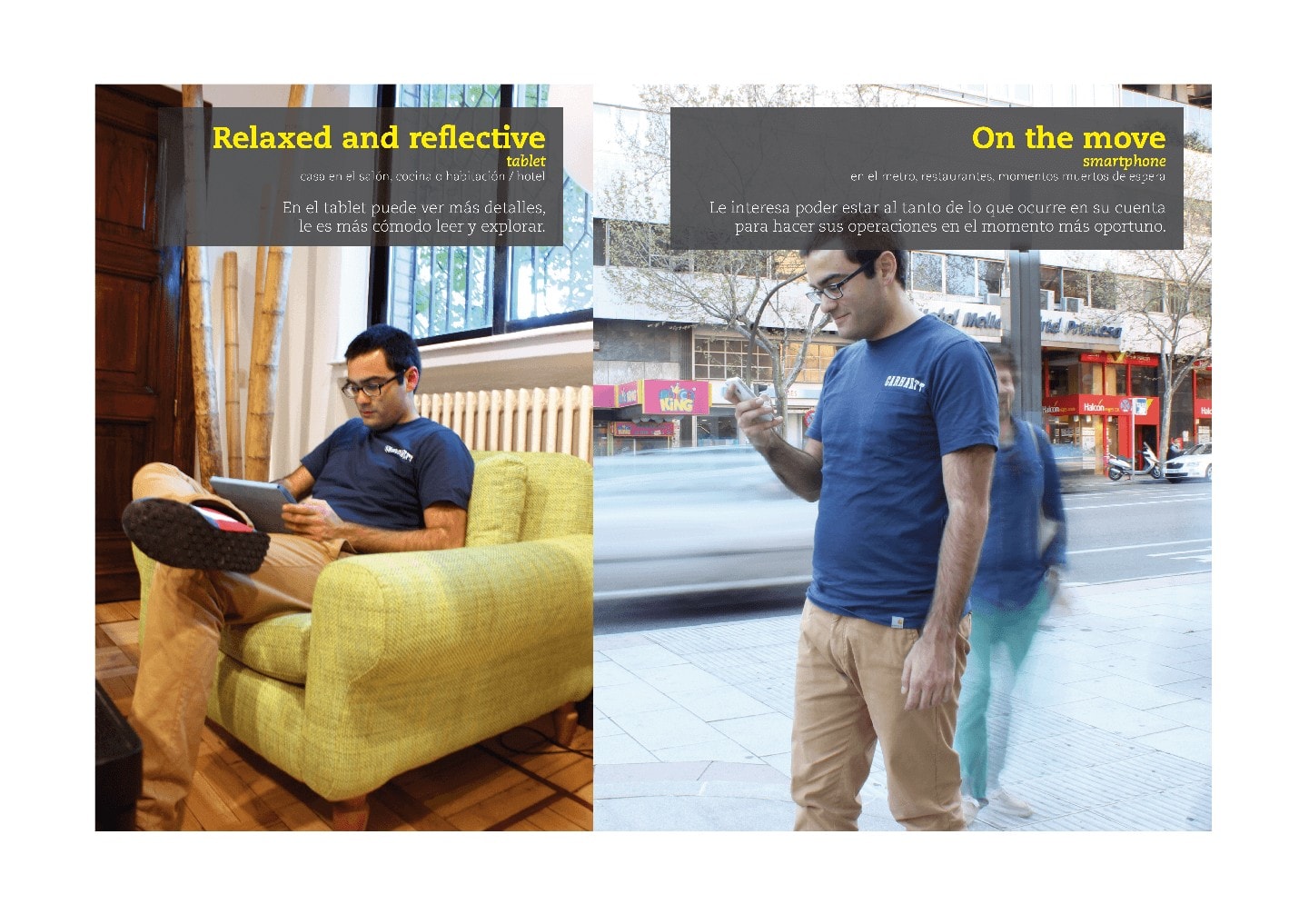
2- Involvement: of all stakeholders working on the project.
Services are created and used, and they exist, thanks to the people in them, and therefore efforts must be made to involve them in the thinking, concept and implementation processes for the service. The people involved must be the ones to change approach, concept or scenario.
The work process is based on continuous sessions with different stakeholders or even in interdisciplinary teams; this will ensure that there is a sustained focus on their needs and concerns, that they are aware of the context, and that they are at all times part of the decisions being taken. In addition to these working sessions, tools are used which enable sharing of all the content on which the team is working to ensure that the process is transparent.
3- Adapt: tactics and strategy.
Service design projects allow you to adapt the company’s strategic vision, i.e. its proposal for added value and business objectives, to the tactical reality: how to transfer such strategy to the daily experience of clients using the means available.
Designers in projects such as these have to constantly zoom in and zoom out, moving between the principles of the design, which set the design decisions, and actual design of the devices, which produces and makes tangible what the company has to offer.
4- Create consistency: all contact between user and service provider must be consistent
The service design tools allow stories to be built from a user perspective, thus ensuring that all user contact with the company makes sense and adds value. The aim is for people to see the service as provided by a single company, rather than by fragmented providers.
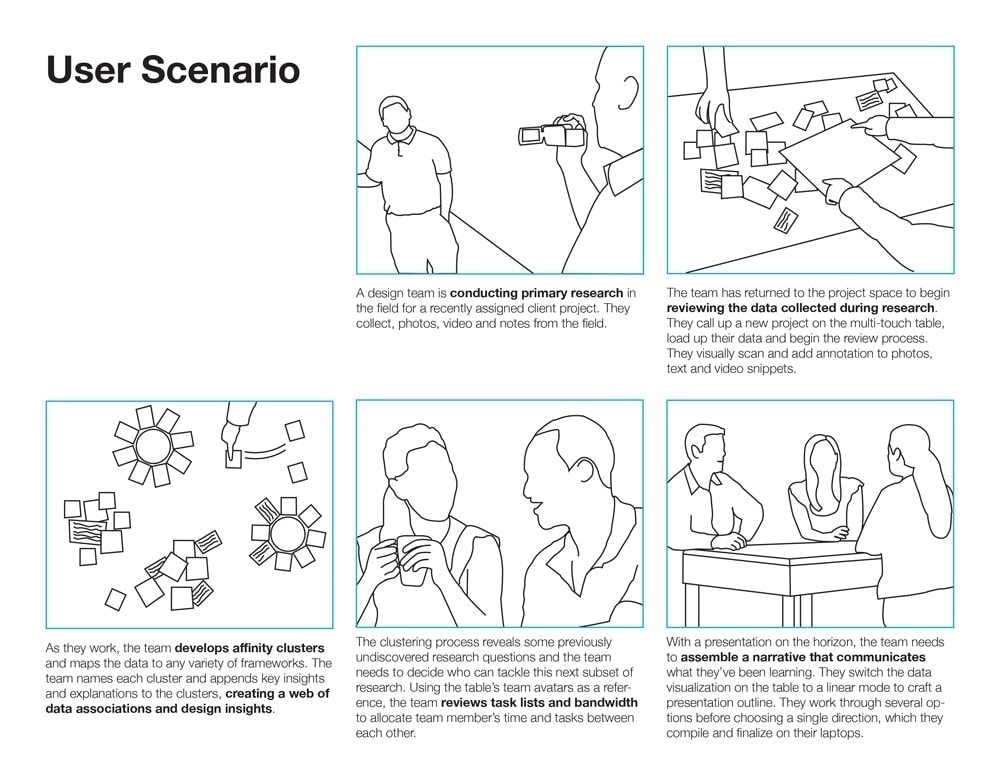
5- Make tangible: an offer of service which materialises
The stories which are created need certain elements for their implementation and materialisation. This is one of the strong points of the design, in that it allows the provision, in objects, digital elements or communication materials, of such aspects as are necessary to facilitate the experience of users and other persons involved.
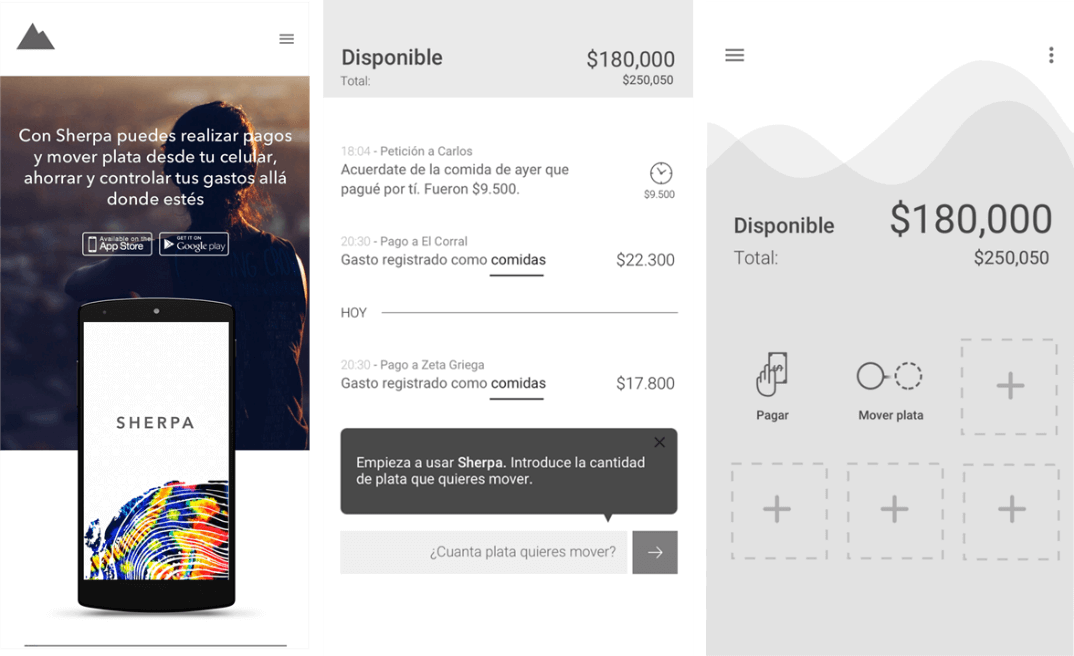
6- Optimisation: making the most of available resources
We don’t believe that innovation necessarily needs a project with a high investment budget and the provision of technology for certain processes.
It is extremely important to make use of available resources, whether material or immaterial, in a pragmatic way, in order to include them in the new service design.
7 – Profitability: define and monitor service KPIs.
We should never forget standards in the design and implementation of services. Setting and monitoring key performance indicators (KPIs) will allow us to measure the impact of the design and replicate if necessary. In our projects we carry out monitoring of KPIs before, during and after the introduction of services.
Addressing the challenge from the perspective of both the business and the user will influence results and impact. Measuring will not always be possible. Measurements will be both quantitative and qualitative, and success will depend on balancing the traditional, accurate measurements of the business with the assessment of those using the service. It is vital to understand that the more disruptive we wish to be and the further we move away from the starting point, the measurements we used before will become increasingly less efficient.
A social project designed with the service design methodology
The service design methodology is without doubt cross-cutting in nature, and can be applied to all manner of activities; from redesigning a shop or high demand product, to the experience of hospital users, to departure areas at an airport.
In this sense, service design can enrich processes aimed at defining new business models for Ferrovial, in both existing and future activities. Moreover, it can help to restructure Corporate Social Responsibility projects.
But it is also useful for improving and activating an enhanced user experience at physical and digital contact points, as in the Ferrovial and Designit joint project. The Ferrovial Digital Hub wished to rethink the passenger digital experience from a user-centred perspective, and they got in touch for us to help them do this in Glasgow airport.
We designed a new web and app from scratch. The web caters to all possible information demands, not only from passengers, but also from friends, airlines and other agents. The app is based on the concept of step-by-step passenger assistance, accompanying the passenger throughout his/her journey through the airport.
The Service Design methodologies and tools were our means of support when taking the most relevant decisions on development and design for both client and user.
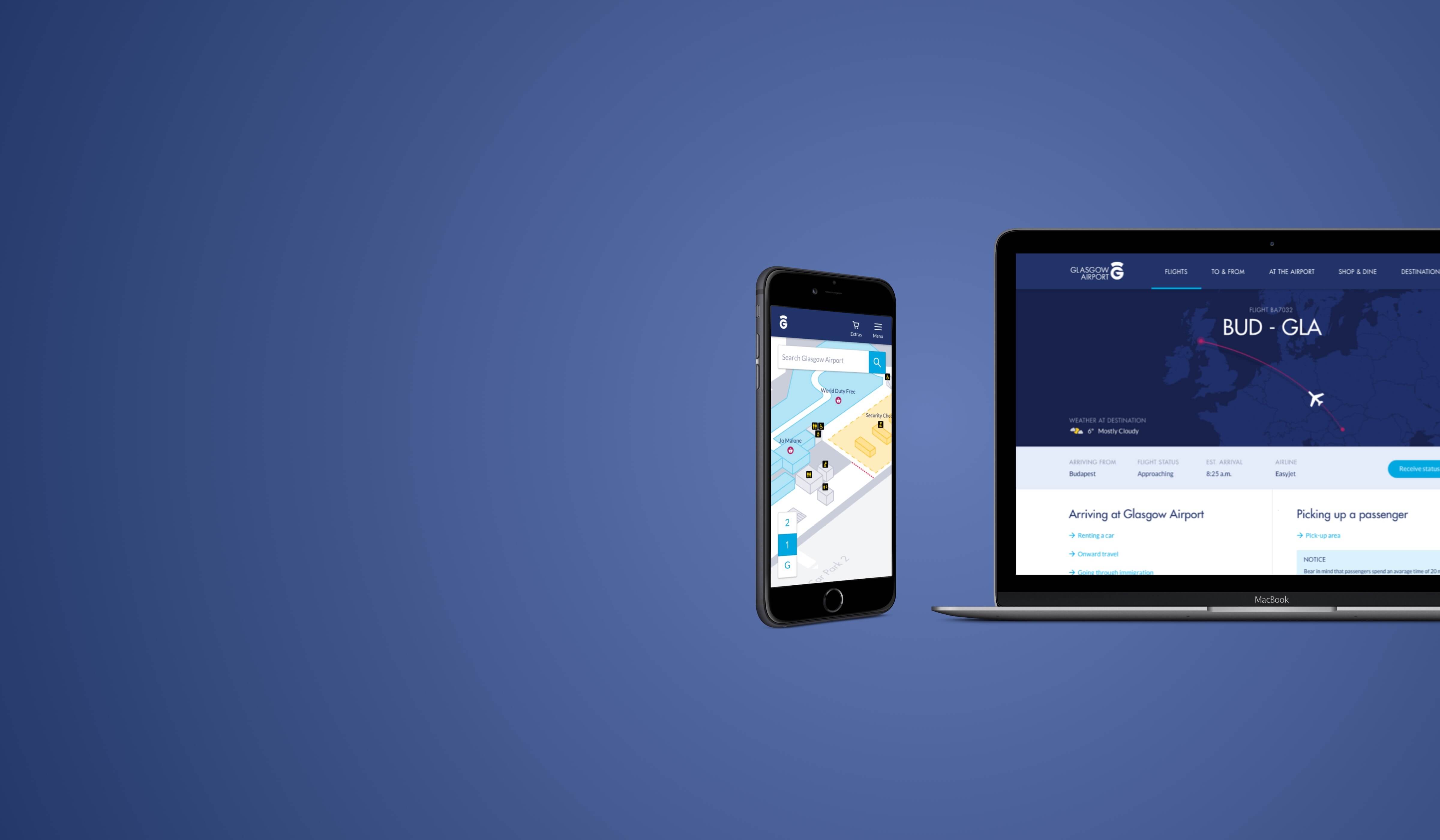
This has also been the case with the design of solutions for improving access to clean water in 15 rural communities in the Buyende district of Uganda. Thanks to the field work of the entire Ferrovial team, an iterative process of service design was developed with the help of ideation tools such as the Canvas Model. In this way, a Customer Journey Map was drawn, to show the route covered by the local population to reach the water collection point and the key locations crossed, in order for the users themselves to understand it better. This process allowed identification of main risks throughout the route. It also served to recognise the central role played by women and the intergenerational responsibility that must be addressed in such transformation processes.
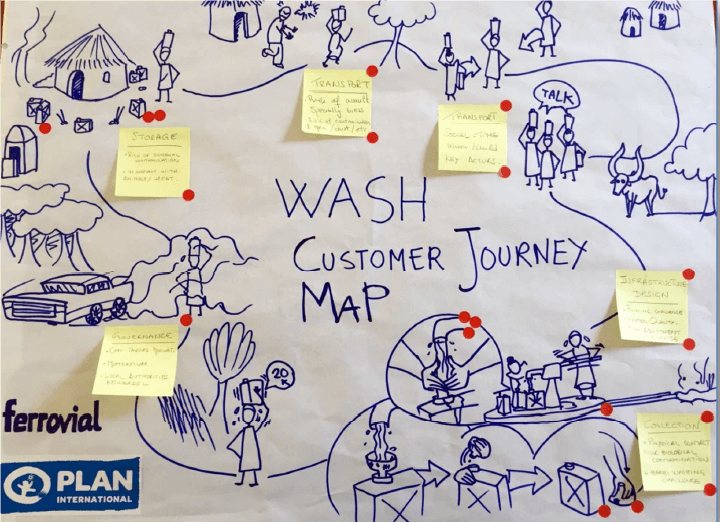
For all the above, service design offers us a new framework for defining projects and business models, and provides us with tools and methodologies to help us step outside our comfort zone and be better prepared for the challenges of the future.

The life cycle of a service can be divided into 5 parts according to the methodology of the ITIL (Information Technology Infrastructure Library):
- Service strategy
- Service design
- Service implementation (implementation and conversion)
- Service operation
- Service development, optimization
Basically, service design focuses on the overall service experience and the design of the service delivery process and strategy. It focuses on crucial points of contact with customers such as initial contact, engagement phase, and feedback on post-consumption experiences. The planning phase must focus on mapping all the key points where the client using the service meets the company. User motivation and feelings at touch points should be analyzed first in order to design a service that complements the current processes with the results of the analysis, and supports the interaction between the user and the service providers.
Even in the case of a bank, the entire banking process is part of the service, from the moment the customer walks in the bank, takes a number, waits in line, gets information and talks to a bank employee or pays money into his account until he leaves the bank. The customer’s experience at different points of the whole process basically determines what they would think of that particular bank. While planning a banking service experience, you also need to find a balance between user needs, the business processes of bank employees, and the particulars of each location.
Changing customer needs and the influence of technology
Many predicted the end of traditional banks years ago when new fintech and banking trends emerged, bringing a better user experience to everyday banking through new products and channels. At the same time, banks seem to be slowly beginning to incorporate market innovations into their services. In the eyes of most users, a bank still remains a reliable institution with a basic function of keeping their funds safe. The market is changing due to customer expectations, market regulation requirements, technology and the different effects of new competitors. Banks have to make a choice: either react to these changes as market leaders or take a defensive stance.
In order for banks to meet the ever-changing needs of the market, they need to focus on the next 6 points
- Building a customer-centric business model
- Optimizing resource allocation
- Simplification of business and operating models
- Acquiring customer information advantage
- Stimulating internal innovation
- Risk management
The pace technology has been evolving in recent years is quite fast. Today, smart phones, cloud computing, and high bandwidth have become the norm. The current focus is on optimizing products and services. The next future trend is digital data collection, resulting in a more targeted, personalized customer offering and munch improved, tailored service. Banks and their partners can map the needs of their customers by creating a more sophisticated customer profile. Developing banks will become customer-centric information and risk-bearing businesses.
Proportion of bank branches per million people. Source: McKensey & Company: World Banking Intelligence Databas
Advancing in cyber security makes it possible to sell banking services online. At the same time, technology makes it easier for customers to switch banks. Customers are much more mobile so they will choose the bank where they will be offered a more personalized service. As a worldwide trend, the use of cash and the number of bank branches is declining due to technological advances and customer demand, so traditional banks are increasingly in need of redesigning their current services and sales channels.
Trust, empathy and commitment are some of the characteristics that modern customers seek when chosing their financial service provider. This means developing banking processes that allow customers to be open, honest, and encourage them to voice their problems freely, build trust with their clients. Fintech companies which are based on a thorough understanding of customer needs, are constantly developing their services and offers, and offer solutions to problems.
banking trend forecast
According to a survey by PwC on the state of the banking sector in 2020, bank directors named 3 main trends for the next period:
- Develop customer-centric perspective and create a frictionless user journey
- Real-time intelligent data integration through artificial intelligence and cognitive computing
- Open banking solutions
According to the PwC research, 61% of banks say the customer-centric model is “very important,” but only 17% are ready implement it.

Significant changes in these areas are expected over the next 5 years based on the PwC survey
The effect of COVID-19 on bank digitization
The effects of COVID-19 are felt in almost every segment of the global economy. The financial sector is also affected in several ways. Banks have reduced their opening hours due to government regulations and can only receive a few customers at a time due to social distancing, thus placing a greater burden on mobile and online banking channels
At the same time, an increased number of customers, both private and corporate, contact their bank for their financial statements to get infor on their investments, loans, mortgages and financial opportunities, as many have lost their revenue streams either fully or partly.
Negative effects of COVID-19 on fintech companies
People are looking for even safer investments than ever before in these financially uncertain times. In general, the decline in household spending and the complete disappearance of certain expenditures (e.g. private and business trips, hospitality) have a negative impact on fintech companies in certain business sectors. This greatly influences fintech companies and their venture capital financing. Due to the decline in demand for financial services provided by some fintech companies, they may have to look for cooperation and investment partners from the traditional banking sector. Some start-up fintech companies may need to close.
Positive effects of COVID-19 on fintech companies
According to Forbes, the use of fintech applications increased by 72% as a direct result of the COVID-19 pandemic. Customer demands for digital banking have increased, putting pressure on the traditional banking sector to move quickly into the field of digitization. Government regulations can have a positive effect on the situation of fintech companies, as they have eased regulations in fintech companies in several countries, thus helping the economy to start back up faster. In addition, the World Health Organization (WHO) supports contactless payment.
How to design a service for the best customer experience?
The primary tool used in the planning of the service is the so-called service blueprint. This is a diagram that allows the designer to see beyond the product and to have a clear picture of the entire system that brings the customer experience to life. Compared to customer journey mapping, which primarily examines customers’ first banking relationship experience, service planning also explores the bank’s background. The behind-the-scenes analysis will be combined with the mapping of the first bank contact, and this will provide a 360-degree overview of the entire service. Thus, the purpose of the service plan is to explore how the structures supporting customer journey work, what are the responsibilities, and what are the rules that determine what can and cannot be implemented.
In order to connect Customer Actions and banking internal workflows, there are at least 3 points to consider to build the plan.
- The process of interactions (Frontstage Action)
- The boundary separating the customer from the bank (Backstage Action)
- The boundaries of internal interactions (Support Processes)

Service plan
A well-functioning banking customer experience can also be planned
Efforts to show the design of retail banking services are already being observed internationally. The Q110- the Deutche bank of Future retail bank in Berlin is a good example: this is a bank where there are no boundaries. The customers are called guests and are greeted with particularly friendly atmosphere and ushered into comfortable meeting rooms built in the bank branches.

AA Q110- Deutche Bank of Future branch
Planning begins with a new approach to the interior design of bank branches. Bank branches are not designed in the typical way. The Q110 bank branches were designed by the same professional responsible for Tom Tailor and Tommy Hilfiger retail stores. Banking products are given to customers in specially designed aluminum boxes. The new bank “guest” starter pack and account opening is presented to customers in a well-thought out manner. It is also remarkable how Q110 uses new technology to complement communication with customers. For an outstanding customer experience, Microsoft Surface system has been installed in the branches so the guest and their advisor can jointly navigate complex financial matters on a table-sized touchscreen. With the introduction of these services, Q110 has doubled its figures in retirement benefit sales.

Microsoft Surface in action in a Q110 branch
Ergomania’s advice for a better customer experience
Worth remembering: the current corporate attitude has an impact on the future.
The future of banking industry depends entirely on a new generation of bankers reshaping their way of thinking according to the needs of the digital age. Some already use the Design Thinking method to provide services that meet customer expectations. Digital banks focus on their customers instead of numbers.
Get the banks ready: Transforming into experience takes the place of digitization.
Digitalization development is no longer enough to survive. Making mobile banking available is no longer enough to make customers satisfied. What happens if the bank’s application is not customer-friendly and difficult to use? What happens when you need to call customer service and across the line the bank worker is not kind but arrogant? The digital transformation makes no sense without banks providing an outstanding user experience. Service planning is what gives the experience.
Customer first!
Service design and design thinking are methodologies allowing UX or CX to tailor the right services and products exactly to customer needs. This customer-centric approach should affect each and every department of the bank. This must be the way forward.
Graphic designer smart. The best financial products are designed the other way around.
By this we mean an unusual top to down design that begins by determining the final value for the customer and ends with the development plan. This is the opposite approach to when the development of a product begins with coding based on business needs.
Watch what the fintech giants are doing!
We are witnessing the integration of active financial solutions into the ecosystem. From Apple’s credit card, via Google’s credit account, Facebook Messenger microtransactions, to crypto and Libra for Facebook: these services cannot and should not be ignored by traditional banks, even though they do not resemble traditional banking at all.
The customer retention method needs to be changed.
Experienced leaders understand that digitization is not just about creating the most modern online and mobile experience, and that satisfaction is determined by customer experience across different platforms. Customer experience should be seamless, especially in cases that are likely to take place through multiple channels, such as the opening of a new account, getting financial advice or solving problems.
Banks need to look at how they can encourage their own employees to shift focus from selling goods to long-term cooperation with the customer in order to be profitable.
Data should be converted into real-time offers and personalized products
The amount of customer data available has increased exponentially in recent years. The challenge is how to turn data into personalized offers that the bank can deliver to their customers at the right moment. A good example to follow is what credit card companies are doing, who have long provided discounts to their customers by release category. Nowadays, they improve customer loyalty and spending distribution by offering site-specific direct offers to their customers when, for example, a customer goes into an electronics store or cinema.
Service planning is a tool for development
In this digital age, it is a big challenge for traditional banks to retain and attract customers unless they find new market opportunities and transform the current customer experience. Inadequate business processes can result in customer frustration or churn. Service planning can be used to assess the critical points in the bank’s internal processes, such as the customer experience, and by developing them, banks can regain their competitive advantage.
Frequently Asked Questions (FAQs)
How can I make my service list more appealing?
Crafting an appealing service list involves a combination of engaging copy, visually appealing elements, and a clear structure. Focus on showcasing the benefits of each service and how they address your client’s needs.
Is it necessary to include pricing in my service list?
While it’s not mandatory, including pricing in your service list can enhance transparency. If you choose not to display prices, ensure your contact information is easily accessible for clients to inquire about specific details.
What role does storytelling play in service list design?
Storytelling adds a personal touch to your service list, making it more relatable. Share success stories, client testimonials, or case studies to illustrate the real-world impact of your offerings.
How often should I update my service list?
Regularly updating your service list ensures that it accurately reflects your current offerings. Consider revisiting and revising it whenever you introduce new services, adjust pricing, or achieve significant milestones.
Can a well-designed service list improve my website’s SEO?
Yes, a well-optimized service list can contribute to improved SEO. Ensure your headings and content incorporate relevant keywords naturally. Additionally, providing valuable information can lead to increased engagement, positively impacting your website’s search rankings.
Should I seek professional assistance for service list design?
If design isn’t your forte, seeking professional assistance is a wise investment. A skilled designer can bring creativity and expertise to ensure your service list not only looks appealing but also effectively communicates your offerings.
Conclusion
Mastering the art of service list design is a journey that pays off in the enhanced perception of your brand and increased client trust. From crafting an engaging introduction to showcasing expertise and addressing FAQs, every element plays a crucial role. Elevate your business with a strategically designed service list that leaves a lasting impression.


